Martine Giguère: from Québec, Canada, to the Pagoda in Florida
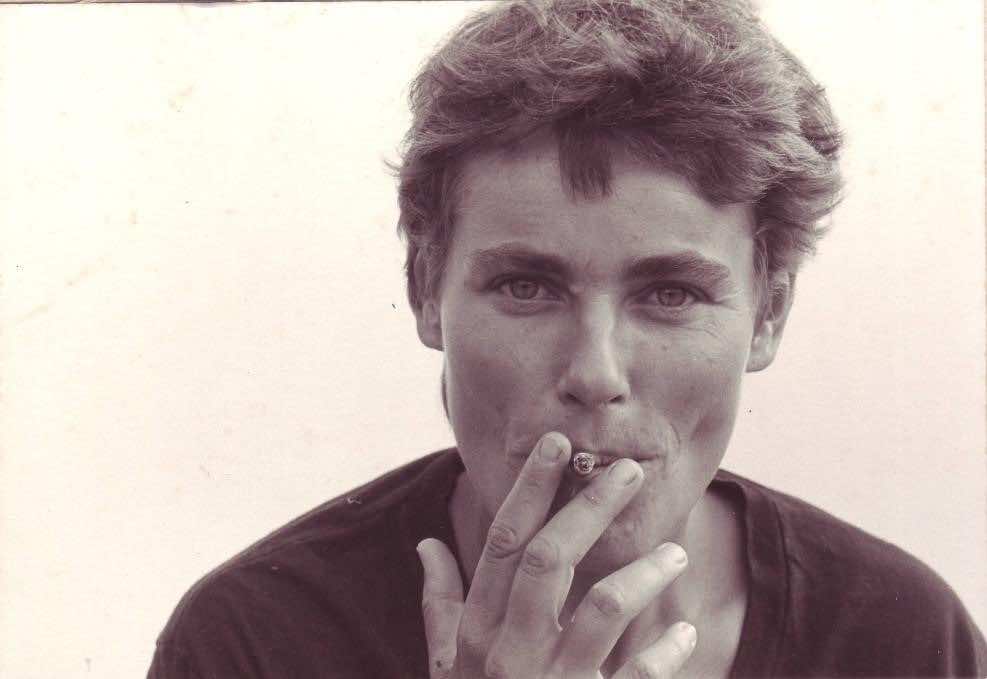
Notes from phone interview by Rose Norman April 12, 2022
Martine Giguère’s Family Background and Education
Martine Giguère grew up in a Catholic family in a small, Canadian town outside of Quebec City, near Maine. Her father was a dentist and her mother was a homemaker. There were five children in the family. Quebec is a French-speaking province. Also, this area has a high percentage of Catholics. She attended a private, all-girl, Catholic, boarding school in Quebec City for her entire, pre-university education, graduating in 1971 at the age of twenty. The boarding school, run by nuns from the Congrégation de Notre Dame. It was a very good school that was remarkably open-minded.
When she finished high school [known in Quebec as ‘college’] in 1971, she moved to Montreal to go to the Université de Montréal. While there, she joined protest groups, fell in love with a woman, and dropped out of school to travel in Europe.
She travelled in Europe, the United States, and Mexico until she was age 27, travelling with three, successive, women lovers. When she came home from Europe, she came out as a lesbian to her parents, who were supportive of her choice.
After traveling, she went back to her university studies, graduating in 1980 with a degree in ethnologie Québécoise, which in English, is the study of societies, cultures, and traditions of Quebec. While at university, she did research in oral literature, collecting stories and legends on contemporary feminist sheroes, such as: healers, goddesses, witches, magicians, cat protectors, giantesses, alternative farmers, etc.
Martine Giguère’s Family Background and Education
Martine Giguère grew up in a Catholic family in a small, Canadian town outside of Quebec City, near Maine. Her father was a dentist and her mother was a homemaker. There were five children in the family. Quebec is a French-speaking province. Also, this area has a high percentage of Catholics.
She attended a private, all-girl, Catholic, boarding school in Quebec City for her entire, pre-university education, graduating in 1971 at the age of twenty. The boarding school, run by nuns from the Congrégation de Notre Dame. It was a very good school that was remarkably open-minded.
Biographical Note
Martine Giguère, born 1951, is from Québec, Canada. She is a carpenter and an artist at heart. She first visited the Pagoda, a lesbian intentional community in St. Augustine, Florida, in summer 1985 with her then-partner, Myriam Fougère.
Martine Giguère was part of a lesbian land group in Quebec, living on rural land with no utilities, when she met Myriam Fougère. They belonged to a lesbian cooperative and a lesbian theatre group in Montréal, Canada. They attended many women’s music festivals, where Martine worked as a carpenter.Martine and Myriam first visited the Pagoda in St. Augustine, Florida, in 1985, returning the following summer to stay. Martine’s worked her carpentry skills with Pagoda residents Rena Carney, Rainbow Williams, and Dore Rotundo on construction projects.
When she finished high school [known in Quebec as ‘college’] in 1971, she moved to Montreal to go to the Université de Montréal. While there, she joined protest groups, fell in love with a woman, and dropped out of school to travel in Europe.
Martine Giguère’s Family Background and Education
Martine Giguère grew up in a Catholic family in a small, Canadian town outside of Quebec City, near Maine. Her father was a dentist and her mother was a homemaker. There were five children in the family. Quebec is a French-speaking province. Also, this area has a high percentage of Catholics. She attended a private, all-girl, Catholic, boarding school in Quebec City for her entire, pre-university education, graduating in 1971 at the age of twenty. The boarding school, run by nuns from the Congrégation de Notre Dame. It was a very good school that was remarkably open-minded.
When she finished high school [known in Quebec as ‘college’] in 1971, she moved to Montreal to go to the Université de Montréal. While there, she joined protest groups, fell in love with a woman, and dropped out of school to travel in Europe.
She travelled in Europe, the United States, and Mexico until she was age 27, travelling with three, successive, women lovers. When she came home from Europe, she came out as a lesbian to her parents, who were supportive of her choice.
After traveling, she went back to her university studies, graduating in 1980 with a degree in ethnologie Québécoise, which in English, is the study of societies, cultures, and traditions of Quebec. While at university, she did research in oral literature, collecting stories and legends on contemporary feminist sheroes, such as: healers, goddesses, witches, magicians, cat protectors, giantesses, alternative farmers, etc.
Lesbian Land Group in Quebec
After university, Martine was one of fifteen lesbians who formed a lesbian land group to buy rural land in the area of Victoriaville, Quebec. She was there from 1981 to 1986 on that land with no running water or electricity. She immediately built a cabin. Later, when she was with Myriam Fougère, she built a treehouse deep in the woods.
Martine and Myriam also belonged to a lesbian co-operative in Montreal, and to a lesbian theatre group. They listened to women’s music and read writings by lesbian feminists from Quebec as well as from the United States and France. Among the writers who influenced her: Kate Millet, Adrienne Rich, Nicole Brossard, Marie-Claire Blais, Mary Meigs (Canadian writer whose English works were translated to French), Jovette Marchessault, Line Chamberland, and Irène Demczuk. Also, Martine mentioned Amazones d’Hier, Lesbiennes d’Aujourd’hui, a newsletter by Ariane Brunet, Louise Turcotte, Danielle Charest, et Gin. Bergeron.
Martine and Myriam attended women’s music festivals, including the Michigan Womyn’s Music Festival, known as MichFest, and the New England Women’s Musical Retreat, known as NEWMR. Note that the featured image of Martine at the top of this interview is of her at MichFest in 1985. Martine was part of that land group until about 1986. She was a festival worker, usually doing carpentry and helping to make the land accessible, like construction of ramps and such.
Finding the Pagoda
Martine recalls that Myriam was exhibiting her art show at Bloodroot, the now-legendary, lesbian bookstore and vegetarian restaurant in Bridgeport, Connecticut. They learned about the Pagoda through the owners of Bloodroot, Selma Miriam and Noel Furie when they she saw a flyer [advertisement] on the wall of the bathroom there, and Myriam arranged to do an art show at the Pagoda. Martine and Myriam drove down to Florida the following summer in 1985.
Martine describes staying in the attic room of the Pagoda guest house, which is the most popular room with its spectacular ocean view. Also striking was the ambient, spiritual sacredness of the Goddess faith. There was the beauty of the ocean, the beach, and the pelicans. In the Pagoda library, Martine found books she could not find elsewhere. She also fondly remembers attending Wiccan circles and making unforgettable friends.
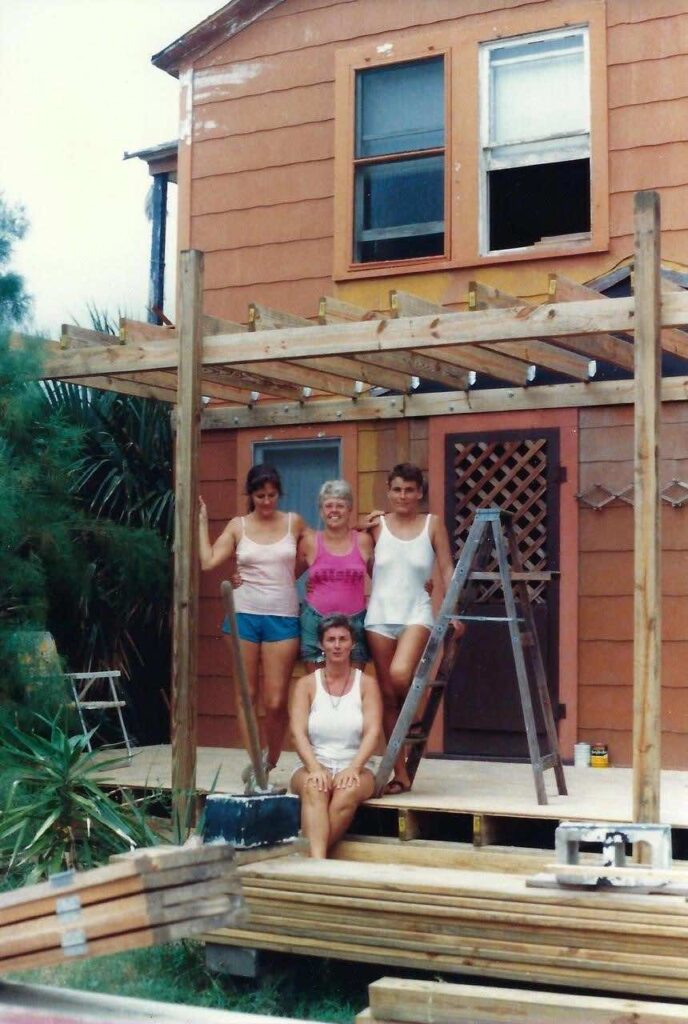
Courtesy of Martine Giguère
Martine and Myriam stayed at the Pagoda from May until the end of July. The exhibit was originally scheduled for May 15 to May 29, and it got extended. They were able to support themselves with local jobs, such as painting the beach house that Kay Mora and Jean Adele had just built next to the Pagoda, a house designed by Dore Rotundo. Through the Pagoda, Myriam was able to schedule art exhibits elsewhere in Florida, such as Gainesville, St. Petersburg, Miami, and Sugarloaf Key. They spent a good bit of time with the women’s community at Sugarloaf, where Blue Lunden, Jane Gapen, Vögel, and others were then living and creating a women’s community.
At the Pagoda, Martine met lesbian peace activists who had been jailed in an antiwar action in South Carolina in 1983, such as Lynda Lou Simmons, Judy Keathley, and Corky Culver. Some of them had used the jail experience as an opportunity to begin recovery from alcoholism. That caused Martine to start thinking about her own relationship with alcohol. “I was often drunk at the time, and very rebellious.” These women made a deep impression on her. They were her inspiration to eventually quit drinking.
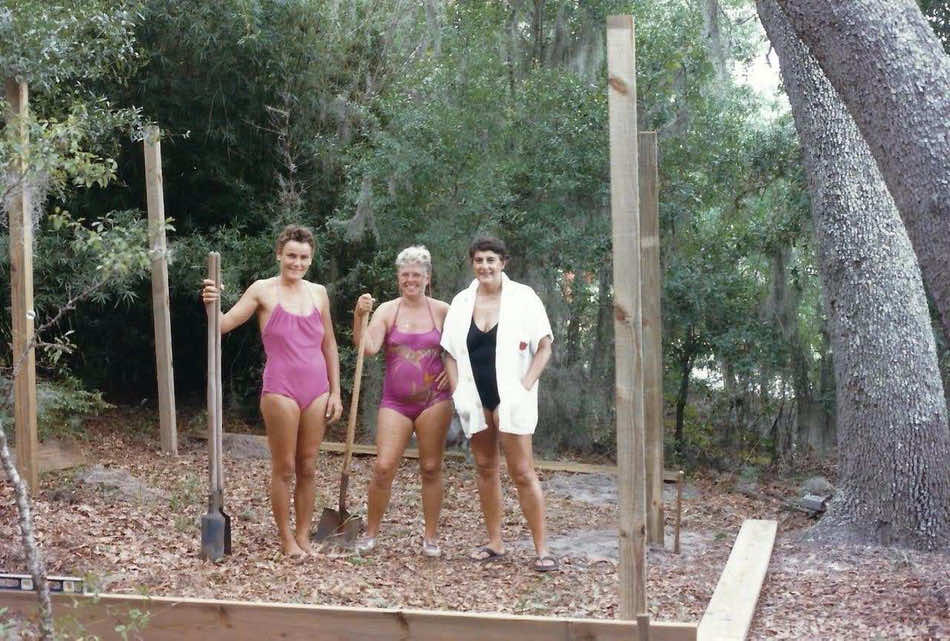
Courtesy of Martine Giguère
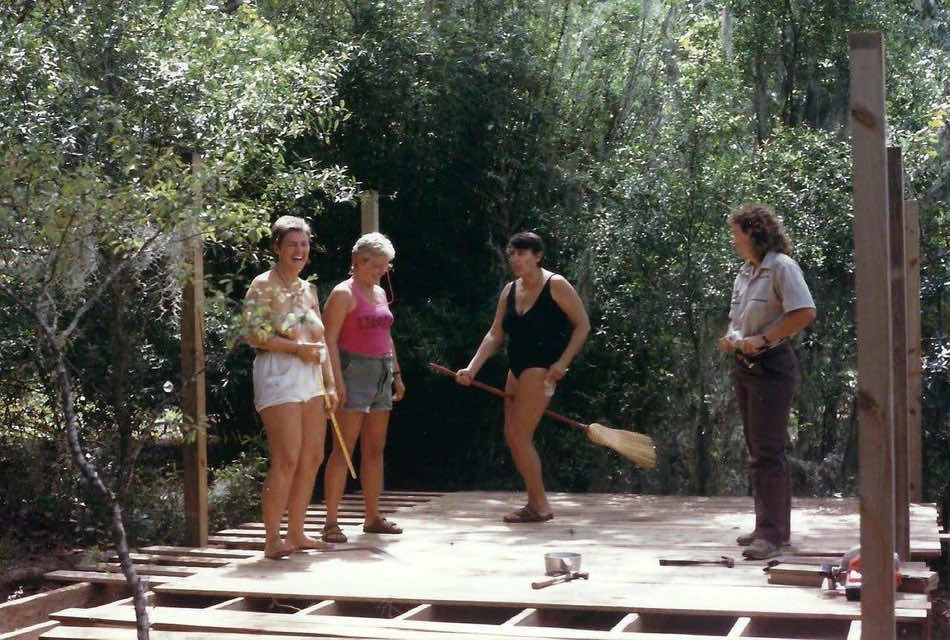
Courtesy of Martine Giguère
Returning to Florida
In 1986, Martine and Myriam returned to Florida, renting a house near Gainesville with Beth Karbe. It was a very beautiful place in the wetlands of the Watermelon Pond. She left Myriam and Watermelon Pond that summer, going back to the Pagoda when Rena Carney had asked Martine to build a porch on the east side of her Pagoda cottage. Rainbow Williams taught her a lot about construction, giving her tips on how to do framing and important things like that. She then went on to build a deck on Rainbow’s Pagoda cottage, which was the duplex, at that time. Through Rainbow, Martine got many other carpentry jobs that summer. Working with Rainbow on those projects gave her a lot of confidence in her carpentry skills. Martine realized that she could make a living doing something like this that she enjoyed doing.
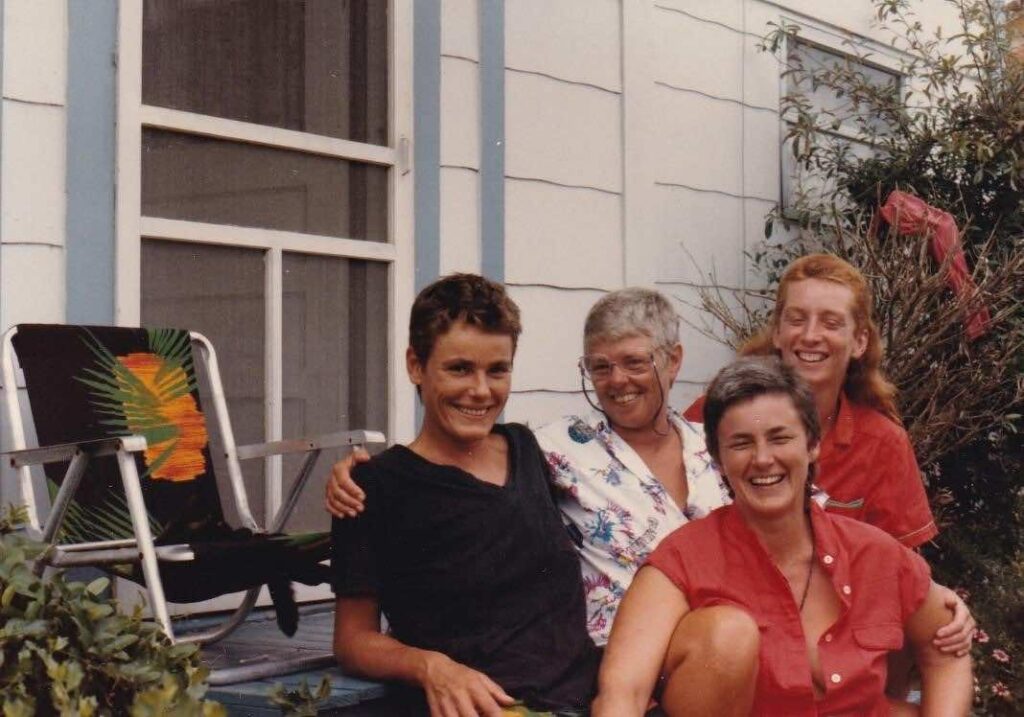
Photo by Emily Greene
Moving to Cape Cod with Deb Ennis, Known at the Pagoda as “Flame”
At the end of that summer, Martine began a relationship with Deb Ennis, known at the Pagoda as “Flame,” who had come to Florida from Connecticut to go to massage school in Gainesville. Deb lived in Montreal through the winter.
At that time, Martine discovered she had cervical cancer, requiring a hysterectomy. After the operation, Martine and Deb moved to Cape Cod. She was with Deb for three years, working as a carpenter on Cape Cod. Martine also quit drinking alcohol.
Back in Montreal
Martine decided to return to Montreal in 1989 because she had long overstayed her visa. Back in Montreal, she found work as a carpenter in the film industry building film sets. She felt very lucky to do that. She has now retired from the trade after thirty years in the industry.
In 1999, Martine and Myriam became partners again, remaining together for twelve years. During that time, they visited Myriam’s Pagoda cottage about twice a year, always doing various projects on the cottage. Martine’s last time visiting there was in 2011.
Thoughts on the Pagoda
Martine’s memories of the Pagoda that stand out for her are the amazing ocean, her carpentry trade, and the wonderful collaboration with Rainbow and other lesbians there, which she particularly cherishes. She said that her time there “got me on my feet and gave a direction to my life.”
Martine and another partner, for the past eight years, have travelled to many other places: Vietnam in 2020, and before that, Mexico City, Mexico. They were leaving for a tour around Italy the week after this interview in 2022.
Timeline Summary
May 1985, Martine Giguère and Myriam Fougère arrive for the first time at the Pagoda in St. Augustine, Florida. Myriam has been a supporter since September and October 1984. She scheduled a sculpture exhibit for May 15 to May 29 of 1985 year; and her exhibition was extended for a couple of months. Sudie Rakusin exhibited paintings at this time, too, at the Pagoda.
June 1985, Martine Giguère and Myriam Fougère have cleared the beach path at the Pagoda.
July 28, 1985, farewell potluck at the Pagoda for Martine Giguère and Myriam Fougère, followed by music in Persephone’s Pit by Rainbow, Sheila (She Fay), Sandi, Patty, and the Amasongs (neighborhood choral society). Martine and Myriam showed slides from Sugarloaf.
Dec 21, 1985 to Jan 6, 1986, Myriam Fougère’s art is on display in in the theatre.
June 14 to June 15, 1986, exhibit of Martine Giguère’s homemade boxes.
1986, photos of 1986 construction projects on Rena Carney’s porch, and on Rainbow’s deck at duplex.
October 1986, three new supporters at the Pagoda: Martine Giguère, Shan Chaney, and Carol J. Windham.
1989, Martine Giguère returned to Montréal, Canada.
1998, photos of Rainbow’s art at Riverview (33 Florida Ave., St. Augustine, Florida).
1999 to 2012, Martine and Myriam Fougère get back together for 12 years, then separate, remaining friends.
This interview has been edited for archiving by the interviewer and interviewee, and for the website. Original interviews are archived at the Sallie Bingham Center for Women’s History and Culture in the David M. Rubenstein Rare Book and Manuscript Library at Duke University in Durham, North Carolina.
See also:
Kathleen “Corky” Culver, “I Get Dry With a Little Help from My Friends,” Sinister Wisdom 124 (April 2022): 135-3, about being jailed for an antinuclear protest at the Savannah River Nuclear Power Plant in South Carolina in 1983.
